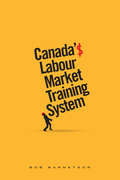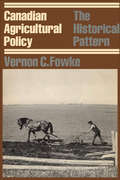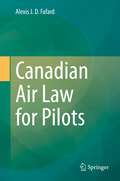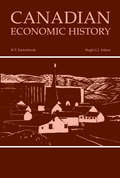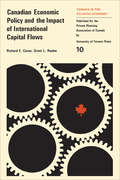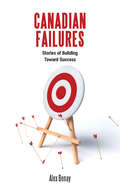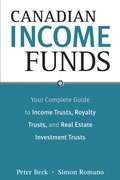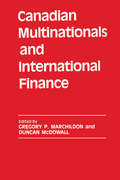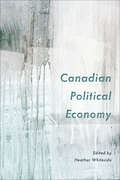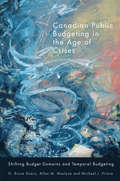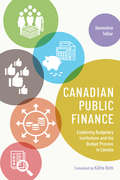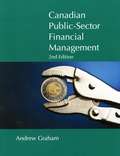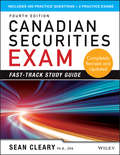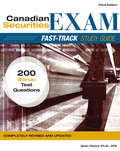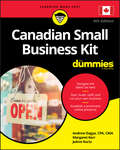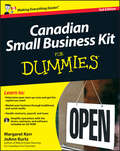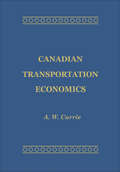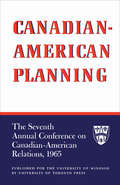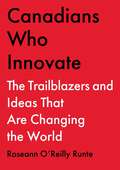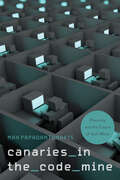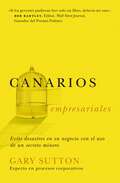- Table View
- List View
Canada’s Labour Market Training System (OPEL: Open Paths to Enriched Learning #6)
by Bob BarnetsonHow does the current labour market training system function and whose interests does it serve? In this introductory textbook, Bob Barnetson wades into the debate between workers and employers, and governments and economists to investigate the ways in which labour power is produced and reproduced in Canadian society. After sifting through the facts and interpretations of social scientists and government policymakers, Barnetson interrogates the training system through analysis of the political and economic forces that constitute modern Canada. This book not only provides students of Canada’s division of labour with a general introduction to the main facets of labour-market training—including skills development, post-secondary and community education, and workplace training—but also encourages students to think critically about the relationship between training systems and the ideologies that support them.
Canadian Agricultural Policy: The Historical Pattern
by Vernon FowkeFirst published in 1946, this historical analysis of Canadian agricultural policy from 1600 to 1930 tests the assumption that agriculture has been Canada's basic industry, central in the economic and political life of the nation. Professor Fowke demonstrates that agricultural interests have always been secondary in shaping agricultural policy. Government attitudes have been influenced less by economic and political agrarian pressures than by such considerations as defence of empire, provisioning of the staple trades, and later the investment opportunities offered to industry, commerce, and finance by an expanding agricultural frontier.
Canadian Air Law for Pilots
by Alexis J.D. FafardCanada is a global aviation powerhouse. Thanks to the British Commonwealth Air Training Plan during World War II, as well as its internationally-recognized reputation enabling an important and meaningful bridge among the nations of the world after the war, Canada — called the Aerodrome of Democracy by President Franklin D. Roosevelt — was chosen as the host of the headquarters of the United Nations’ International Civil Aviation Organization (ICAO) and influential International Air Transport Association (IATA), and has become the third-largest aerospace hub in the world. Today, thousands of Canadian aviation professionals specializing in engineering, management, finance, sales, flight operations, academics, flight training, tax, and law staff the ICAO, IATA, governmental agencies, airline companies, law and aircraft leasing firms, universities, and gigantic aerospace corporations. This Canadian expertise also resonates in today’s global training pipeline of highly skilled professionals operating winged-tubes loaded with thousands of gallons of kerosene fuelling complex and powerful engine systems in the lower levels of the stratosphere to carry passengers and/or cargo across intercontinental airways.Canadian Air Law for Pilots is entirely dedicated to pilots; its purpose is twofold: (1) to highlight the landmark Canadian legislative framework relative to aviation law, and provide an extensive review of federal decision-makers affecting pilots’ privileges, rights, and interests by reporting on their purposes, procedural rules, as well as key case law within administrative and penal law; and (2) to outline Canada’s air law for local and international applicants and trainees interested in obtaining pilot permits, licences or ratings (aeroplanes) issued by Transport Canada.This textbook is divided into four parts: Part I: Administrative LawPart II: Penal LawPart III Aircraft in CanadaPart IV: Air Law
Canadian Economic History
by W. T. Easterbrook Hugh G.J. AitkenThrough three centuries of development, the history of the Canadian economy reflects the shifting roles of natural resources, industrializations, and international trade. This volume, a standard in the field since its initial publication in 1958, presents a comprehensive account of these and other factors in the growth of the Canadian economy from the time of the earliest European expansion into the Americas. The authors consider economic organization both on the level of the national economy and on that of the individual business unit. Among the subjects examined are the growth of the fur, fishing, and timber trades; the impact of successive wars; money and banking; the development of railway and canal systems; the wheat economy; the growth of organized labour; and twentieth-century patterns of investment and trade. The focus throughout is on the role played by business organizations, large and small, working with government, in creating a national economy in Canada.
Canadian Economic Policy and the Impact of International Capital Flows
by Grant Reuber Richard CavesThe object of this study is to investigate the effects that complete and formal integration of the Canadian with the American capital market would have on the Canadian economy. It is based largely on recent trade statistics, particularly those of the period when the exchange rate floated. In summary, the short- and long-run effects could both be beneficial to Canada. This study is a convenient summary of a longer work by the same authors to be published in 1970.
Canadian Failures: Stories of Building Toward Success
by Alex BenayThe Hill Times: Best Books of 2017 Successful Canadians write about failure, and how it got them where they are today. What does it mean to fail? To some of the most successful Canadians, it was a rite of passage, a stepping stone to greater things, or even a brilliant source of inspiration. Olympic golds, successful businesses, pioneering medical advances — all came about after a series of missteps and countless attempts. Canadian Failures gathers ten experts from the private, public, and not-for-profit sectors and academia, all of whom have grappled with failures and success throughout their lives. Their powerful argument: that Canada, and Canadians, must be willing to learn from failure if we hope to succeed. With Chapters By … astronaut Robert Thirsk Olympic gold medalist, wrestler Erica Wiebe Chair of OpenText and of the National Research Council, Tom Jenkins co-founder of the Just for Laughs comedy festival, Andy Nulman … and others at the top of their fields.
Canadian Income Funds
by Peter Beck Simon RomanoIncome trusts are booming. They have been one of the best-performing classes of investments in one of the worst markets in decades. With over 150 trusts currently trading on the Toronto Stock Exchange at a combined value of over $90 billion, this relatively new vehicle, the income fund, is one of the hottest tickets on the Canadian investment landscape today. Written by two of the industry's top experts and commentators, this is the first book of its kind: a complete guide to the income trust industry in Canada. Includes complete coverage on: what income funds are and how to use them to your advantage; myths and facts about income funds; different types of income trusts; what to look for in an income trust, and how to assess the risks involved; how income trusts, and the investors in them, are taxed; funds of income funds; and much more. Explains what business owners need to know if they are considering converting their businesses into an income trust. Features listings and profiles of over 160 income funds currently available in Canada, including a description of each fund, performance history, and contact information. Designed for anyone interested in knowing how Canadian income funds work, including: investors, business owners, directors, trustees, stockbrokers, financial advisors, lawyers, accountants, investment bankers, and commercial bankers.
Canadian Multinationals and International Finance
by Gregory P. Marchildon Duncan McDowallSeven studies explore the modest but significant role of Canadian multinational enterprises in world finance, trade, and direct investment. Presents a historical overview, analyses of individual companies, and considerations of whole industries.
Canadian Pacific's Bid for Norfolk Southern
by Benjamin C. Esty E. Scott MayfieldIn December 2015, Canadian Pacific Railroad (CPR) has just made its third bid to acquire Norfolk Southern Corporation (NSC), one of the largest railroads in the United States. Having rejected the prior offers, NSC's CEO James Squires and the NSC board must now value the current offer including the projected merger synergies as well as a recently-added contingent value right (CVR) designed to "sweeten" the offer, and decide how to respond.
Canadian Political Economy
In Canadian Political Economy, experts from a number of disciplinary backgrounds come together to explore Canada’s empirical political economy and the field's contributions to theory and debate. Considering both historical and contemporary approaches to CPE, the contributors pay particular attention to key actors and institutions, as well as developments in Canadian political-economic policies and practices, explored through themes of changes, crises, and conflicts in CPE. Offering up-to-date interpretations, analyses, and descriptions, Canadian Political Economy is accessibly written and suitable for students and scholars. Through 17 chapters, the book’s topics include theory, history, inequality, work, free trade and fair trade, co-operatives, banking and finance, the environment, indigeneity, and the gendered politics of political economy. Linking longstanding debates with current developments, this volume represents both a state-of-the-discipline and a state-of-the-art contribution to scholarship.
Canadian Public Budgeting in the Age of Crises: Shifting Budgetary Domains and Temporal Budgeting
by G. Bruce Doern Allan M. Maslove Michael J. PrinceIn the aftermath of the 2008 financial crunch, a pending era of budgetary austerity looms over Canada. Canadian Public Budgeting in the Age of Crises provides a roadmap through the difficult fiscal decisions that have characterized contemporary federal politics across four decades. The authors provide an accessible and comprehensive overview of the constraints that have affected budgetary outcomes in the recent past and that will affect the near future, with analysis spanning micro, macro, social, environmental, and intergenerational domains. They examine the current Harper government's Conservative era, but also look at public budgeting under Chrétien, Mulroney, and Trudeau. Set in the crucial context of macroeconomic policy shifts and in a global comparative context, Canadian Public Budgeting in the Age of Crises broadens and deepens our understanding of government spending, borrowing, and taxing. Budgetary domains - complex realms of fiscal content, choice, and governance - are introduced and balanced against an analysis of these domains with pertinent and up-to-date discussions on institutional influences, dominant actors, and shifting power imbalances.
Canadian Public Finance: Explaining Budgetary Institutions and the Budget Process in Canada
by Genevieve TellierBroken down into five sections explaining how public budgets are developed, Canadian Public Finance presents a comprehensive account of the budget process of the federal, provincial, and territorial governments. With a specific focus on the public policy process, Geneviève Tellier walks readers through the five steps involved in the budget process including agenda-setting, formulation, adoption, implementation, and evaluation. Taking a close look at how much influence key decision-makers actually have over the budget process, Tellier highlights recent events that reveal the political, social, and economic constraints that impact budgetary decisions. Tellier uses key words and textboxes at the end of each chapter to reflect on current issues and new developments in the world of public finance, such as gender-sensitive budgets, performance-based budgeting, and fiscal transparency.
Canadian Public-Sector Financial Management, Second Edition
by Andrew Graham"It's not your money - it belongs to the people." Taking this simple axiom seriously creates unique challenges for the management of public funds. Andrew Graham outlines all aspects of public sector financial management, addressing how funds are obtained, what rules of accountability and accounting are applied, who controls public funds, what constitutes effective budget management at the operational level, and how accountability and oversight are dealt with. The skills demanded of public sector managers in financial management are becoming increasingly onerous and complex. Canadian Public Sector Financial Management will be of great help to practitioners in the public sector who wish to better understand their financial responsibilities as well as to students of public administration and the general reader concerned with public financial management issues. The second edition of Canadian Public-Sector Financial Management updates the widely used text, reflecting on the developments in public financial management over the past six years. Developments in financial reporting and the widespread need for governments to constrain growth and manage their finances more closely are looked at. It remains focused on the practitioner and manager in the public sector.
Canadian Residential Mortgage Markets: Boring But Effective?
by John KiffA report from the International Monetary Fund.
Canadian Securities Exam Fast-Track Study Guide
by W. Sean ClearyWhether your career aspirations lie in banking, financial planning, the mutual fund industry or a brokerage, you can't avoid taking the Canadian Securities Exam. But there's a lot of material to know for the day of the examination, and it can be a daunting task to assimilate such a wide body of knowledge. The Wiley Canadian Securities Exam Fast-Track Study Guide is a quick-review tool that covers all the basics you need to know to pass the exam. It presents "quick hits" of the key points you need to know, in language that's easy to understand and follow. This concise study aid: summarizes the essential, "need-to-know" information highlights important topics features multiple choice review questions at the end of each chapter makes material easy to read, understand and remember includes two practice exams and double the number of review questions in the last edition This edition has been completely updated and revised to reflect recent changes to the course and the exams. It features updates throughout, new questions and new practice exams, and it has been restructured for ease of use and comprehension. Don't let the stress and amount of material you need to know for the exam overwhelm you. Prepare yourself with the Wiley Canadian Securities Exam Fast-Track Study Guide. It's the perfect quick-review tool to wrap up your studying and help you focus on doing your best on the exam.
Canadian Securities Exam Fast-Track Study Guide
by W. Sean ClearyWhether your career aspirations lie in banking, financial planning, the mutual fund industry or a brokerage, you can't avoid taking the Canadian Securities Exam. But there's a lot of material to know for the day of the examination, and it can be a daunting task to assimilate such a wide body of knowledge. The Wiley Canadian Securities Exam Fast-Track Study Guide is a quick-review tool that covers all the basics you need to know to pass the exam. It presents "quick hits" of the key points you need to know, in language that's easy to understand and follow. This concise study aid: summarizes the essential, "need-to-know" information highlights important topics features multiple choice review questions at the end of each chapter makes material easy to read, understand and remember includes two practice exams and double the number of review questions in the last edition This edition has been completely updated and revised to reflect recent changes to the course and the exams. It features updates throughout, new questions and new practice exams, and it has been restructured for ease of use and comprehension. Don't let the stress and amount of material you need to know for the exam overwhelm you. Prepare yourself with the Wiley Canadian Securities Exam Fast-Track Study Guide. It's the perfect quick-review tool to wrap up your studying and help you focus on doing your best on the exam.
Canadian Small Business Kit For Dummies
by Andrew Dagys Margaret Kerr JoAnn KurtzThe bestselling book you need to succeed in small business Canadian Small Business Kit For Dummies is the bestselling Canadian guide to starting and running a successful small business. This guide covers every aspect of starting, building, staffing, and running a small business. Offering information for entrepreneurs starting from scratch, people buying a business, or new franchise owners, it features updated information about the latest tax laws and its impact on small businesses, along with insight into how small business can take advantage of social media such as Facebook, LinkedIn, Twitter, and Instagram, etc. Covers the latest changes to taxes, finances, and marketing Helpful forms on Dummies.com make learning easier Expert advice makes this a worthwhile investment for all entrepreneurs Brand-new coverage devoted to starting a cannabis business If you’re looking to start a new business—or want to improve the one that’s already underway—this helpful guide makes it easier.
Canadian Small Business Kit For Dummies
by Margaret Kerr Joann KurtzCanadian Small Business Kit For Dummies is the bestselling Canadian guide to starting and running a successful small business. This guide covers every aspect of starting, building, staffing, and running a small business, offering information for entrepreneurs starting from scratch, people buying a business, or new franchise owners. With updated information about the HST and its impact on small businesses, insight into how small business can take advantage of social media such as Facebook, LinkedIn, and Twitter, and new resources, including information about new sources of government funding for small businesses, this book is an essential guide to small business success.Note: CD-ROM/DVD and other supplementary materials are not included as part of eBook file.
Canadian Transportation Economics
by A. W. CurrieA.W. Currie's Canadian Transportation Economics describes and analyses the economics of transport in Canada whether by rail, highway, inland and coastal waterways, the high seas, air or pipeline. It is written to be of interest to employees of railways, steamship companies, airlines, and pipelines, to operators of motor vehicles, to shippers, consignees, and other businessmen, to professional economists and to citizens generally.
Canadian-American Planning: The Seventh Annual Conference on Canadian-American Relations, 1965
by University of WindsorThe Seventh Annual Seminar of Canadian-American relations held at the University of Windsor brought together a number of distinguished participants, representing such interested groups as labour, business, and research, to discuss planning. The result is this volume which brings together some of the contributors to discuss this important and controversial area of Canadian-American relations.The noted economist Harry G. Johnson begins by defining planning in the Canadian-American context as "the general process of attempting to take stock of the present situation and its evolving trends, predict the general direction of future developments, assess these in the light of generally accepted social and economic goals, and where necessary formulate programs and policies designed to shape future developments as closely as possible to conform to what is considered to be in the social interest." He then identifies several promising areas for joint planning, including the liberalization of trade, the use of energy, the use of water resources, and the organization of transportation. Subsequent papers on official and business planning echo the approach outlined in Dr. Johnson's definition, and stress the need for vision based on discernment of where we are and where we are going. These discussions are grouped into the categories Business, Labour, New Areas of Co-operation, Automation, and Technical Change.Finally, Paul Ylvisaker, Director of the Public Affairs Program for the Ford Foundation in New York, under the title "The Human Price of Planning" adds a cogent warning that this future focus, however skilfully it is related to present knowledge, may not be enough, pointing to recent events in the University of California at Berkeley and in Watts, California, as an indication of the importance of being prepared for and receptive to the immediate and unexpected. He suggests that planning for the cities of the future should be the most important concern for Canadian and American planners.By bringing together a variety of viewpoints on some of the most relevant aspects of planning for the future this volume will provoke lively discussion, and provide a useful reference, for all those who will take part in planning for the future, and those who will be affected by it.
Canadians Who Innovate: The Trailblazers and Ideas That Are Changing the World
by Roseann O'Reilly RunteProfiles of some of the most inventive and creative Canadians and the ideas that are making Canada a leading nation in innovation.From saving lives to saving harvests... From discovering ancient diamonds to identifying the first exo-planet... From driverless cars to quantum computers... From Nobel laureates to your next-door neighbor... This book offers uplifting stories of innovative Canadians. Canadians Who Innovate includes two Nobel laureates, an astronaut, extraordinary business leaders, the godfathers of artificial intelligence, and top quantum experts, including the inventor of what may be the next quantum computer. It features profiles of the first director of engineering at Google, who is now working on nuclear fusion; a medical researcher who communicates on TikTok about the efficacy and potential for RNA vaccine technology; and a PhD in nuclear physics who has twice won the Scotiabank Giller Prize. Meet the linguist who works with Indigenous people to make online dictionaries, an internationally consulted specialist on migration, an agri-tech investor, a world specialist on permafrost, and the expert in systems and number theory who has a way to fix health care. And don&’t forget the engineer who grew human cells on apples, a feat that is leading to the creation of replacement organs that do not require donors—not to be confused with the aerospace technology developer who created a tethering system to clean up space debris and a 3-D printer that prints biological tissue. Featuring brilliant thinkers from coast to coast to coast, and others from around the world who now call Canada home, Canadians Who Innovate paints a promising picture of a cleaner, healthier, more innovative future for us all.
Canaries in the Coal Mine: Realizing a Better Work-Life Balance for All
by Sylvia Ann HewlettThis chapter addresses the challenge of accelerating and expanding the scope of alternative work arrangements to reach the critical mass needed to transform corporate culture.
Canaries in the Code Mine: Precarity and the Future of Tech Work
by Max PapadantonakisThe idea that the tech industry is a secure field with jobs and opportunities for growth is a myth. There is widespread precarity among software developers, who experience uncertainty, anxiety, and imposter syndrome as technological advancements threaten job security. Max Papadantonakis investigates this phenomenon in his revealing study, Canaries in the Code Mine. He indicates that precarity is not just about the risk of losing one’s job; it is about living in a career where basic needs and rights are not guaranteed. Interviewing 120 software developers from leading tech firms, Papadantonakis shows how temporary contracts, project cancellations, and company downsizing undermine the security of even highly skilled professionals. He also highlights the systemic inequalities that shape the tech industry, showing how age, race, and gender often dictate the opportunities and responsibilities software developers have—or are denied. Canaries in the Code Mine highlights a disturbing reality of privilege and vulnerability within the tech industry. Papadantonakis engages in a critical discourse on the evolving nature of work in the digital era, emphasizing the need to shape an equitable future in the rapidly evolving landscape.
Canarios empresariales: Avoid Business Disasters with a Coal Miner's Secrets
by Gary SuttonLos administradores están preocupados. Y deben estarlo. Las compañías Fortuna 500 despidieron más gente de la que contrataron en las últimas dos décadas. Las bancarrotas y los fraudes abundan. En el tumultuoso ambiente de los negocios de la actualidad, los administradores quieren una guía que sea apropiada y concisa, una metáfora única y memorable y que se salga de lo común. Precisamente eso es lo que Canarios empresariales conjuga.Hay una escasez de libros de negocios que ofrecen esa guía. Se necesita un tema oportuno, una metáfora pegajosa y una mercadotecnia fuera de lo común. Eso es lo que Canarios empresariales presenta. El libro ofrece una guía práctica, alertándoles a los administradores cuando sus negocios están yéndose a pique.Hace un siglo los mineros colgaban jaulas para canarios en sus túneles. Los pajaritos se callaban cuando un gas venenoso penetraba en la mina, dando a los trabajadores un aviso del peligro que se avecinaba. De la misma manera que los canarios protegían a los mineros, los conceptos de negocios en Canarios empresariales protegerán a los negocios alertando a los ejecutivos y a los administradores cuando sus negocios estén por enfrentar serios problemas.El libro presenta cinco capítulos vitales que revelan cinco de los peligros más comunes en los negocios, y cada lección está acompañada por una historia basada en el abuelo del autor y su trabajo en la industria del carbón, junto con un « aviso preventivo de canario» aplicable para cada tema.
Cancer Screening in Japan: Market Research and Segmentation
by John A. Quelch Margaret RodriguezSince founding CancerScan in 2008, Jun Fukuyoshi and Yoshiki Ishikawa had helped to improve cancer screening rates in Japan. Between 2005 and 2007, awareness of breast cancer in Japan rose from 55% to 70%, but the incidence of breast cancer screenings remained constant. Jun and Yoshiki applied marketing research techniques to increase the screening rate for breast cancer, a disease which killed over 12,000 Japanese women in 2011. Cancer screening initiatives accounted for 60% of the company's 2013 sales of $2.5 million.
